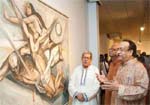 Bengal Gallery of Fine Art has organised a solo painting exhibition of recently demised eminent artist Bijan Choudhury, which has become a treat for art connoisseurs who have adoration for the paintings of the Indian accomplished artist.
Bengal Gallery of Fine Art has organised a solo painting exhibition of recently demised eminent artist Bijan Choudhury, which has become a treat for art connoisseurs who have adoration for the paintings of the Indian accomplished artist.
The exhibition titled ‘A tribute to Bijan Choudhury’ showcases a total of 33 exquisite paintings by the artist from the collection of Bengal Gallery, art collectors and from Kolkata, where he migrated to in the late 1950s from Dhaka.
Born in 1931 in Kotalipara of Faridpur district in Bangladesh, Bijan Choudhury was initiated into the field of art by his father Kunjabihari Choudhury. Young Bijan was admitted to Sonai School in Kalighat in Kolkata and later continued his art-related education at Kalighat Oriental Academy. The influence of the traditional Pot Chitra is vivid in his paintings. Bijan, who moved back to Bangladesh, got admitted to the first batch of Dhaka Art College, which enriched him under the close tutelage of Shilpacharya Zainul Abedin.
Bijan’s rich artworks, having influences of traditional art blended with modern art and cubism, explores mythology, life of ethnic minorities, the aggression of so-called modern life and the inner mind, love and emotions of human beings.
Robust human figures, elongated noses and eyes, men and women with native poses are visible on the canvases of Bijan. Translucent beauty of rural Bangla through the momentum of figurative drawings showed Bijan’s emotional attachment with the people of rural Bengal.
Politically conscious artist Bijan Choudhury used his canvases, brushes and colour to dissolve socio-political exploitations and raise consciousness of proletariats. Victory of the have-nots, joyous looks of ethnic minorities in deep jungles, images of horses resembling vigour, are visible on some of his canvases.
His active participation in the historic Language Movement in the 1952 and his realization of the power of mother tongue is shown in a canvas titled ‘Mayer Bhasha Bangla Bhasha’, which depicted a martyred man while another wounded man is nursed by a woman language activist. An evil-spirited face, depicted on the top of the canvas, reflects the ominous situation that prevailed during the movement.
His affection for music is also portrayed on some canvases which depict baul singers rendering songs, playing traditional instruments ektara, dotara and others, while some paintings on raag-ragini and love of Radha Krishna added intensity to the whole collection.
One of his fabulous paintings named ‘Untitled-3’ shows two fallen male figures and an anguished woman, done in oil. Bijan provided a refined acrylic look on the opaque medium of oil and maintained a brilliant play of light and shade on the canvas, highlighting the pain of oppressed classes.
The exhibition, which began on May 22, will remain open from 12:00 pm to 8:00 pm until May 31.
-With New Age input




















